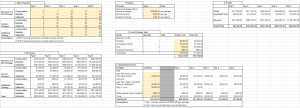1.Refine the detailed income statement for your venture for two years (at six month intervals) or a more appropriate time scale. Explicitly state the assumptions that underlie your financial model ——Shown Above
2.Refine the Business Model for your venture based on your revenue model. You may use the Osterwalder BMC to refine your business model but prepare one or more visuals that explain how your venture will work and accomplish your BHAG.
1. Customer Segment
- Entrepreneurs: See the opportunity in obtaining cheap raw material that can be used to create a higher-value product to be sold back into the marketplace
- Non-profits: organization previous clean beaches and discards the collected plastics into the landfill, which goes back to the ocean. The venture provides them a methodology that ensures plastics from returning to the environment
- Donors:
- Barangay/government is interested in providing financial aid to motivate people in starting the venture because it diverges post-consumer plastic waste from the landfill while providing employment opportunities.
- Plastic manufacturers are interested in providing financial aid as a way to offset their negative environmental image to the public.
2. Customer Relationships
- Service plan that offers maintenance of the recycling machinery in the facility
- Junkshop: Connects junkshops to ventures as suppliers to ensure the venture’s success
- Machine Manufacturer: Offers a business opportunity for manufacturers to earn an income in selling the machinery to us
3. Channels:
- Website- connect to people, provide entrepreneurs with information on the venture
4. Value Proposition
- We provide the Filipino community a sustainable approach to reducing plastic pollution by offering entrepreneurs the opportunity to transform post-consumer plastic waste into higher-value products that can be sold back to the community.
5. Key Activities:
- Maintaining connections with all the recycling facilities that start their plastic venture
- Providing the training needed to operate the recycling machinery
- Provide the installation service needed to start the recycling facilities
- Reach out to other entrepreneurs to start their venture
- Conducting business with the manufacturing company to provide our customers with the machinery to start their venture
- Network with junk shops to connect them to our customers as suppliers
6. Key Partners:
- Machine Manufacturer
- Mold Maker
- Government (ensure our plastic products meets standards)
7. Key Resources:
- Machinery Fabrication facility
- Junk shops
- Connections with entrepreneurial groups
8. Cost Structure:
- Machinery
- Machinery installation, maintenance, training
- Traveling for network maintenance and opportunities
- Overhead
9. Revenue Stream:
- Business in a box package: establish facility, training, and connections to ensure success in business
- Service plan: machinery maintenance
- Advanced machinery training
3. Develop an M&E plan for your venture.
- Clearly list all assumptions.
- Entrepreneurs will only produce the products that we decide for them (wall system)
- Entrepreneurs would run their facilities at the classical 8 hours per day rate
- Entrepreneurs will honestly report their sales on a monthly basis
- Entrepreneurs will reveal the amount of plastics they purchase from the junk shop
- Identify short-term and long-term success metrics.
- Short term:
- The number of plastic bricks sold on a monthly basis
- The number of facilities in Manila per volume of plastic waste
- Long term:
- Amount of post-consumer plastic that are turned into products and sold
- The number of micro recycling facilities that have been built and have recovered their capital investment
- Short term:
- Identify specific methods to measure the metrics.
- Provide some sort of benefit, such as a discount towards service plan (machinery maintenance), for entrepreneurs who report
- the amount of bricks they sell
- the amount of post-consumer plastics obtained from junk shops
- Provide some sort of benefit, such as a discount towards service plan (machinery maintenance), for entrepreneurs who report

